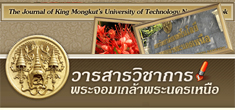บทคัดย่อ
Mean Residence Time (MRT) was determined numerically for the pilot packed bed reactor filled with the ceramic raschig rings. Three well-defined patterns and one randomly packed bed were studied, where a tube-to-particle ratio (N) was around 7. A case study of Dry Methane Reforming (DMR) was investigated at 600 °C, 1 atm. Reactant feeding rates were varied in the range of 0.985 to 2.957 L/min. The MRTs of four difference packing pattern, namely, vertical-staggered (pattern 1), chessboard-staggered (pattern 2), reciprocal-staggered (pattern 3), and randomly packed bed were conducted using finite-element based Computational Fluid Dynamics (CFD). The results were shown in terms of E(t) function where a higher value of the E(t) function means greater deviation from the ideal plug flow. Results showed that chessboard-staggered pattern had the lowest E(t) values compared with all patterns and all feeding rates. To deeply representative results for the system configurations, the discussion on non-ideal behaviors of each structured packing can be made systematically in this work.
คำสำคัญ : Mean Residence Time, Residence Time Distribution, Packed Bed Reactor, Dry Methane Reforming and Computational Fluid Dynamics




